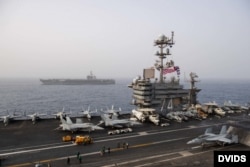The United States announced last week that it would not renew sanctions waivers it has granted countries that import Iranian oil. The current waivers will expire on May 2. Importers that would continue purchasing Iranian oil beyond that day will risk being penalized and lose access to U.S. financial markets. The U.S. would push to bring Iran’s oil exports to near zero.
The Iranian President Hassan Rouhani and some senior military commanders have threatened to disrupt oil shipment from the Persian Gulf, including implicit and explicit threats to close the Strait of Hormuz, if Washington would prevent Iran’s oil exports.
The U.S. has taken the Iranian threats seriously. Gen. Kenneth “Frank” McKenzie, Jr, the new commander of the United States Central Command (CENTCOM), said on Saturday that the United States would deploy the necessary resources to counter any dangerous actions by Iran. On 15 April, CENTCOM deployed F-35A Lightening IIs to Al Dhafra Air Base in the UAE, the first deployment of the fifth-generation multirole aircraft to the Persian Gulf.
There are two carrier strike groups led by USS John C. Stennis and USS Abraham Lincoln conducting carrier operations in the Mediterranean, with the combined force of 130 aircraft, 10 ships, and 9,000 sailors and marines. These forces would be deployed closer to the Iranian shores in short order if the situation called for it. And there are hundreds of U.S. fighter jets and dozens of warships already based in the region. The U.S. has a formidable force in the vicinity of the Persian Gulf to counter Iranian military threats.
Washington’s concerns go beyond military threats and include terrorist acts by Iranian proxies in the region and even in the U.S. homeland. The director of the FBI said last week that his agency takes the threats coming from IRGC-Qods Force and its proxies seriously. The Qods Force has recruited, armed, trained, and financed young Shia radicals across the Middle East - Arabs, Afghans, and Pakistanis. The IRGC has put their total number at 200,000. Many have seen combat in Syria and Iraq under the command of the Qods Force. They constitute a formidable pool of ideologically committed and highly trained fighters with many years of combat experience. Iran can use this force for terrorist attacks on U.S. and allied targets if it chooses to.
As disconcerting, is the possibility that in post-Syrian and Iraqi civil wars, Iran could not properly manage its proxy forces, for a number of reasons including shortage of cash to pay salaries, resulting in breakaway of some radical elements to form their independent terrorist cells to take up the fight against U.S. and allied interests.
Back to Iran’s immediate threats against U.S. forces, the theater of operations will not necessarily be limited to the Persian Gulf. The major Shia militia groups in Iraq under the command of the Qods Force, for example, could restart their attacks against U.S. personnel and facilities in the country. During the Iraq War of 2003-2011, more than 600 U.S. servicemen were killed by Iranian EFPs and IEDs, the anti-armor and roadside bombs planted by the Qods Force-led Shia militias against U.S. forces.
Those Shia militias can now move against U.S. military installations and diplomatic posts in retaliation for stopping Iran’s oil exports and for adding the name of their mother organization, the IRGC, to the list of Foreign Terrorist Organizations (FTOs). In Yemen, the Houthis, trained by the Qods Force, could use Iran-supplied anti-ship cruise missiles and explosive boats to hit U.S. and allied ships transiting through Bab el-Mandeb, or even attempt to close the strategic waterway, which like the Strait of Hormuz is a major chokepoint through which a significant percentage of global trade, including oil, transits.
Although the United States is taking the threats by Iran’s military and its proxies seriously and is organized to counter them, the Iranians might not act on their threats and regard the risks simply too high. The closure of the Strait of Hormuz or major moves against U.S. forces in the region could soon escalate into a larger regional conflict, putting the very existence of the Islamic Republic at risk.







